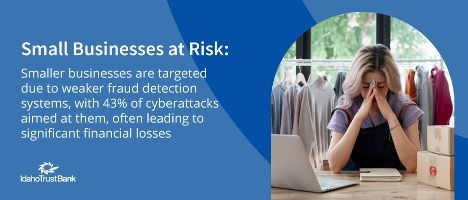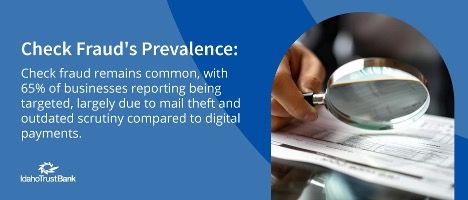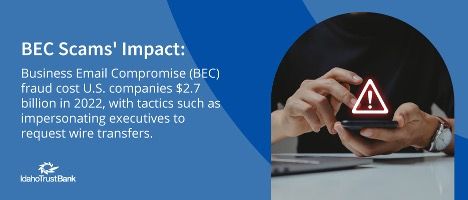Protecting your Idaho Business Against The Rise in Payment Fraud
Published: 12/09/2024
Protecting Your Idaho Business Against the Rise in Payment Fraud
Much in the world has changed since the pandemic that began in 2020, including the ways that we do business. One of the lasting effects is the rise in electronic payment methods being used by companies of all sizes across the globe. This doesn’t just refer to your clients’ and customers’ payment methods. Business-to-business transactions are largely electronic as well, leaving your business more exposed to scammers, phishing attempts, and payment fraud.

Protecting your business from fraud is vital. Businesses lack the same financial fraud protection offered to individual consumers and, in fact, it’s very rare that funds are fully recovered. In 2023, 80% of surveyed businesses were the victims of fraud attacks or attempts, according to the Association of Financial Professionals. Out of these businesses, less than half of payment fraud victims were able to recover more than 75% of their stolen funds.
What does this mean for your business? It means that attempted fraud should be seen not as a possibility but as a near-certainty. It also means that whether it’s Amazon, a big-box retailer, or a family-owned business in Coeur d’Alene or Boise, all businesses in Idaho should take measures to prevent, or at least limit, payment fraud.
What Are the Different Types of Payment Fraud?
Scammers and fraudsters have different ways of defrauding your business. As digital security technology improves and the populace becomes more tech-savvy, the unscrupulous have modified their tactics to stay ahead of the game. However, some more traditional fraud methods persist and can harm your business.
Check Fraud
Check fraud remains one of the most prevalent forms of fraud, with 65% of surveyed companies reporting that they’ve been targeted. In an increasingly digital world where fewer people write checks, why is check fraud not only prevalent, but on the rise?
There are a few reasons:
- Checks are notoriously vulnerable to fraud. After all, checking and routing numbers appear on all checks.
- With heightened scrutiny and security given to digital transactions, less attention is being paid to check transactions.
- Advances in fraud techniques such as check washing and digital forgery have made check fraud harder to catch.
- Stolen check information can be stored and sold through different channels on the Internet.
- There is a greater delay in detecting check fraud compared to digital payment fraud.

Much of the increase in check fraud, like all payment fraud, can be traced back to the pandemic and our increased reliance on mail, which has led to a rise in postal theft. Despite the pandemic being over, check fraud continues to surge throughout the business sector.
BEC Fraud
Business Email Compromise (BEC) fraud is an email scam where fraudsters impersonate a trusted person or vendor. They may target employees, business associates, or top executives. The goal of BEC scams is to gain the trust of a person in order to obtain sensitive data or account information. In 2022, companies lost $2.7 billion to BEC scams. Just this summer, the town of Gooding, Idaho lost $1.1 million in a BEC scam.
BEC scams typically originate through phishing attempts. Once fraudsters have gained access to company and associated emails, they use the following tactics:
- Mimicking the email of an executive or vendor
- Pushing the target to act quickly
- Making common requests, such as wire transfers or changing bank information

Educate your employees in recognizing suspicious requests and phishing attempts, especially those who handle finances, such as Accounts Payable, as they are likely to be targeted over other employees.
ACH Fraud
The Automated Clearing House is a money-transferring network that connects banks, credit unions, and other financial institutions. Payments such as direct deposits, apps like Venmo and Zelle, and most online bill payments run through the ACH (credit card payments do not). Because of the expansiveness of the ACH and the number of transactions processed daily, it has become a prime target for scammers. In fact, 67% of payments targeted by BEC scams in 2023 were made by ACH.
What Can My Business Do To Prevent Payment Fraud?
While no amount of security measure will make your business 100% impervious to payment fraud, there are a wide range of measures that can be taken. Robust financial security is not only a matter of having the most recent software but of having educated and responsible employees who know how to spot and respond to fraud.
Security Measures
There are a variety of fraud protection measures that can be taken proactively. Some of the most common are Positive Pay and ACH Positive Pay, both of which help to block digital check fraud. With these, you are able to avoid unauthorized transactions, limit duplicate checks, and approve payments. However, because it is up to you to approve or deny payments, it is still possible that fraud can occur, especially if you approve a high number of transactions daily.
You’ll also want to implement multi-factor authentication for payers and payees. This extra level of security will hinder scammers looking to impersonate employees, clients, or vendors.
Another layer of security can come from segregating duties involving financial transactions. By having separate employees responsible for beginning, approving, and reconciling payments, it is less likely that phishing scams or BEC fraud will be committed, as it would have to get past multiple sets of eyes.
Train Employees to Recognize Fraud and Phishing Attempts
With the advancement of security software and technology, fraudsters often find that human error is the most likely avenue to a successful scam. To minimize these errors, your employees should be regularly trained to stay up to date on the newest scamming trends. They should not only be aware of the various types of fraud discussed above, but they should be able to identify red flags that might indicate fraud. These include current phishing scams, unusual transaction activity, unknown vendors, pushy requests for information, and any other payment or invoice that seems odd.
Employees should also know the procedure when they suspect or encounter payment fraud. This ensures that the appropriate department of party in the company is made aware and can respond in a timely manner.
Monitor Transactions and Reconcile Accounts Quickly
Ideally, this should be done daily. Other prevention methods are meant to make it as difficult as possible for scammers to access your financial information, but this is how you spot it when it happens. The faster you identify when payment fraud has occurred, the quicker you can respond to it and mitigate your potential losses.
Use Fraud Detection
Aside from vigilantly monitoring your accounts and transactions, more advanced fraud detection can help. Advancements in data analysis, artificial intelligence, and web monitoring can alert you to everything from unusual transaction patterns to phishing attempts to authentication issues.
If you’re ready to start protecting your business from payment fraud, the business banking professionals at Idaho Trust are here to answer any questions about fraud prevention and how to protect your business’s finances. Contact us today and set up your business with Positive Pay and ACH protections!
